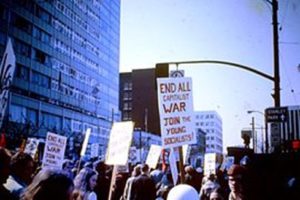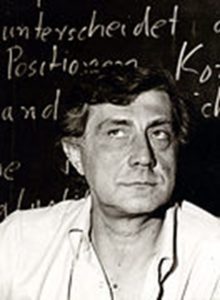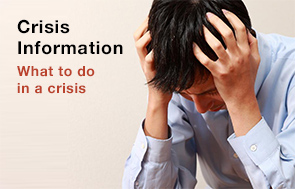The Anti-Psychiatry Movement
Origins
The anti-psychiatry movement is a loose political and social movement which sprang up in the 1960s in the US and Europe and which has gone through a number of transformations along the way. The movement probably had its ideological roots in the widespread dissatisfaction that was taking place on both sides of the Atlantic in the 1960s on the practice of housing and treating people with mental illness in the large institutional asylums.
Criticism of the asylums system was two fold. Firstly there were a number of scandalous revelations of very poor and sometimes abusive conditions in some but by no means all of the asylums and secondly there was a growing belief that incarceration in an asylum would lead to the process of “institutionalisation” of the patient. A process whereby the patient began to deliberately or unconsciously behave insanely in order to survive the environment of the asylum.1

The nascent protest movements of the 1960s created fertile ground for the birth of the anti-psychiatry movement. (Image: John Hill, Creative commons attribution on Wikimedia Commons)
The 1960’s was a time of new radical ideas when the accepted political, social and cultural norms were under scrutiny as never before. It was the time of anti-war movements, radical student movements, free love, gay liberation and the hippies and it was therefore not surprising that the psychiatric profession should also come under scrutiny at this time. Besides many psychiatric practices such as compulsory electro shock therapy and psycho surgery were increasingly being seen as inappropriate to the age and incompatible with modern ideas on human rights.
And some of the arguments of the anti-psychiatrists were very seductive, for instance the assertion that because schizophrenia did not involve any obvious physical changes to the brain nor be detected by any physical test it could not be a real disease, was one that many people accepted. Into this climate came an anti-psychiatry movement that did not simply argue for a more humane approach to psychiatry but actually questioned its very foundations.9
The anti-psychiatry arguments were also very appealing to some churches who saw mental illness and the disturbed behaviour that it causes as being essentially a moral issue that was rightfully the domain of religion rather than a medical issue to be treated by doctors.11
However the anti-psychiatry movement was not simply about radical new ideologies it also tapped into a deep-rooted dissatisfaction with previous psychiatric practices. For instance the new gay movement saw the psychiatric profession’s classification of homosexuality as a mental illness and attempts to “cure” homosexuals by the use of aversion therapy as particularly oppressive. There was also a growing awareness of the abuses that had occurred in the old asylum system and a genuine desire for improvement.
R. D. Laing and the British Anti-Psychiatry Movement

British psychoanalyst R.D. Laing who became the doyen of the anti-psychiatry movement of the 1960’s. (Image: Robert E. Haraldsen on Wikimedia Commons)
Ronald D. Laing, a Scottish psychoanalyst, became both the nucleus and the architect of the anti-psychiatry movement in the UK. His idea that schizophrenia was “a sane reaction to an insane world”6 appealed to many of the 1960s radicals who did indeed see a world in which young children in war zones were routinely napalmed for the sake of a superpower’s prestige as insane.
Laing’s idea was that the person with schizophrenia was simply the scapegoat of a dysfunctional family and was paradoxically often the most sane person in the family group.6 He said “without exception the experience and behaviour that gets labelled as schizophrenia is a special strategy that the patient invents in order to live with an unliveable situation” 2
This was an unhelpful point of view. To suggest to anyone suffering from the terrifying paranoia or the persecutory voices that so often accompany an episode of schizophrenia that they have quite voluntarily adopted their condition of their own volition would be greeted with mirth by many sufferers. And besides for many sufferers their psychosis interrupts what was otherwise a happy time of promising employment or academic prospects and certainly not a period of their life that they found in any way unliveable.
In Laing’s theory it was society and particularly the patient’s family who were to be blamed for their deviant behaviour which was then labelled as mental illness and treated within the institution system which would, so the theory went, only reinforce the behaviour.2 Laing in particular saw poor parenting as the cause of schizophrenia because he had had a very difficult relationship with his own parents.4

Conflating politics with health care, the anti-psychiatry movement blamed the nuclear family for schizophrenia. (Image: Juice Flair on Shutterstock)
The family theories around schizophrenia became very popular in all areas of the mental health field and greatly influenced both health service policy and day-to-day psychiatric practice. Families were often stigmatised as being the cause of the patient’s problems and sufferers would be removed from their supportive family environments and sent to live in seedy bedsits or unsupported bed and breakfast accommodation where they were often vulnerable to the predatory attentions of their neighbours.
Laing’s views did not endure. Following the failure of his supportive community project, Kinglsey Hall and as he grew older he became increasingly disillusioned with his former views and later he would remark to an interviewer “ I was looked to as one who had the answers but I never had them”.
It is important to remember that Laing was only at the centre of what was an extremely popular movement with widespread public support. His meetings were usually packed out and he became a media star. His first two books: The Divided Self and The Politics of Experience became best sellers and his ideas were quickly taken up by prominent figures in stage and TV such as Ken Loach and David Edgar who produced films and plays about mental illness heavily influenced by Laing’s ideas. He also had, it has to be said, considerable popularity amongst the younger generation of psychiatrists and in fact many in the medical profession did not see Laing’s views as threatening at all but as progressive and despite the fact that Laing’s work, like most of those pioneers of the anti-psychiatry movement, lacked any solid evidence base his ideas were extremely influential at the time.
The Legacy of the Anti-Psychiatry Movement
Although the anti-psychiatry movement was opposed to the old treatment methods such as electro shock, when the new antipsychotic medications became available they were very quick to castigate psychiatry for using them as well and vociferously highlighted the side effects of the new drugs and played down their beneficial effects even in some cases suggesting that psychosis was actually caused by the antipsychotics.
However one of the most harmful ideas propagated by the anti-psychiatry movement was that psychosis could actually be a positive and life-enhancing experience.5 Indeed Laing’s founding of the Kingsley Hall community was designed to support schizophrenia sufferers in their journey through their own “inner space” rather than to seek treatment for their disabling and distressing symptoms.
Although many at the time saw the nascent anti-psychiatry movement as being a more humane alternative to traditional psychiatry in fact this was in large part illusory. The anti-psychiatry movement saw dangerous behaviour on the part of a person with schizophrenia as being essentially criminal and to be dealt with by the criminal system rather than the health system3 and as a result in the US as well as Europe many people with schizophrenia ended up in prison being punished for their condition rather than in the health system where they properly belonged. A situation that sadly still persists today.
Governments, always looking for opportunities to save money, were then and are still today easily seduced by the arguments of the anti-psychiatry movement and seize on them as pretexts for cutting spending on mental health beds and psychiatric services.3 During the seventies across Europe and the US the old institutions both bad and good were summarily shut down and their patients sent to live in inadequate bed and breakfast accommodation often without any meaningful therapeutic support.3
US and Europe
One of the other founding fathers of the anti-psychiatry movement was Professor Thomas Szaz, an American psychoanalyst who proposed that schizophrenia was a myth created by psychiatrists in their own interest.2 He described schizophrenia as “a fake disease” and “the sacred symbol of psychiatry”6 Szaz is often cited by the Scientology movement as supporting their beliefs although in truth even Szaz did not share many of the more extreme beliefs of that group. Although a psychoanalyst by trade, Szaz did not in fact work with people with schizophrenia and nor did he ever produce any research evidence to support his theories.

Italian Psychiatrist Franco Basaglia whose policies saw people with schizophrenia moved out of the asylums and into the prisons. (Image: M Lucan, Creative commons attribution on Wikimedia Commons)
In Europe the anti-psychiatry movement had its biggest successes in Italy where the main proponent of the anti-psychiatry movement, the psychiatrist Franco Basaglia successfully enlisted support for the new movement, which he called Democratic Psychiatry, from trade unions and the flourishing student movement and was successful in achieving wide ranging changes to the law which abolished the old asylums and made compulsory hospitalisation illegal.
The Italian asylums were replaced by small mental health units attached to the general hospitals in which the length of stay was limited to a maximum of 48 hours. The new system was seen as a great success by the supporters of the anti-psychiatry movement however the statistics for outcomes were heavily skewed by the fact that two important groups, the very old and the very young, were excluded from the new units and took no account of the very large number of people with disturbed behaviour who now ended up in prison as there was no suitable accommodation available for them any more in the health system.
The Anti-Psychiatry Movement Today
Today’s anti-psychiatry movement is very different to that of the 1960’s. In the 1980’s treatments in psychiatry changed radically, dosages of antipsychotics and therefore their attendant side effects were reduced, the use of electro shock treatment went into decline, psychosurgery ended, homosexuality was removed from the classification of diseases and research confirmed the organic roots of the condition that we call schizophrenia. Diagnosis also improved so that schizophrenia could no longer be seen as the catch all diagnosis for nebulous mental health problems that it had previously been seen as. With the changing conditions and the decline in the liberation politics of those days the anti-psychiatry movement declined but didn’t fade away completely. And whilst the early movement had a discernible if informal organisation today’s anti-psychiatry movement is less tangible and is an association more of ideas than of organisations.
In the US and UK today the anti-psychiatry movement still endures as a small but very vocal coalition of Scientologists, old fashioned adherents to 60’s anti-psychiatry, ex. psychiatric patients who are, for a variety of reasons, dissatisfied with the treatment they received in the mental health system and have established themselves as self-styled “survivors” and some sections of the modern hearing voices movement. However the original ideas of Laing and the other European and US doyens of the anti-psychiatry movement remain a key element in their ideology.
The Scientologsists in particular, seeing psychiatry as competing with their own psychological treatment methods7, are well funded and supported by prominent celebrities such as film stars John Tavolta and Tom Cruise and have become extremely influential, even being able to influence United Nations policy on mental illness.10.
However the anti-psychiatry movement still today wields influence beyond its numbers both in terms of government policy and in the third sector organisations (the charities) that play such a key role in the provision of mental health services in the UK. In many areas it is still sadly the case that some practitioners see a diagnosis of schizophrenia as being more harmful than the illness itself and there exist government- funded projects whose stated aim is to “divert” young people with psychosis away from the mental health system. A policy as reckless as it is inhumane. The anti-psychiatry movement often opposes attempts to improve provision of psychiatric services8 and continues to play right into the hands of government bureaucrats ever ready to spot an opportunity to cut back on care for the mentally ill.
The old family theories of schizophrenia have recently been making a come back as well. Promoted very heavily by some psychologists and a few psychiatrists, the idea that adversity during childhood can lead to schizophrenia later in life is once again seducing many in the mental health field. However this hypothesis was tested widely by research in the latter half of the 20th century and was generally disproved. And after all if childhood adversity did lead to schizophrenia then we would expect to see epidemics of schizophrenia in groups like concentration camp survivors and victims of civil wars but such epidemics simply have not occurred. Childhood adversity may be psychologically damaging but it doesn’t cause schizophrenia.
In recent years also many in the psychology profession have taken up the anti-psychiatry banner. There has, of course, been a traditional professional rivalry between the psychiatrists and the psychologists but whereas recently psychiatrists have shown themselves more than ready to embrace the value of the psychologist’s talking therapies many psychologists have sought to play down the benefits of psychiatric interventions.
Far too many psychologists today are arguing that the antipsychotic medications don’t work, or if they do work that most people with schizophrenia stop taking them, that side effects are so severe as to be unacceptable and that in any case the talking therapies that they provide are more effective in treating psychosis than the psychiatrist’s pills. All these statements are quite untrue yet these ideas often receive a ready reception in the media and help to reinforce the myths that perpetuate the poor quality of health care received by so many people with schizophrenia in the UK today. This year over a thousand people with schizophrenia in the UK will die by their own hand and what we know is that those people are in danger when they stop taking their antipsychotics. What is needed here is not internecine rivalry between the two professions but an acknowledgement that recovery from schizophrenia can only be achieved by treating the whole person using an holistic approach combining both the antipsychotic medications and the talking therapies.
The anti-psychiatry ideology is also prominently represented in some parts of the modern hearing voices movement in the UK. This movement, which sprang up in the 1990s, originally focussed on the phenomenon of voice hearing and drew on recent research that claimed that voice hearing was a common experience for many people who did not suffer from mental illness and whose voices would often be benign rather than persecutory.
However, since its inception part of the movement has expanded its writ to include not only all types of hallucinations including visual hallucinations that they call visions and olfactory and tactile hallucinations (hallucinations of smell and touch) but now also to include delusions such as paranoid delusions. It has thus shifted visibly from being a single-issue focus group that had something new and useful to add to the debate on hearing voices to a general mental health lobbying network with a broadly anti-psychiatry stance.

Rather than focussing on the benefits that antipsychotic medicines have brought to thousands the anti-psychiatry movement stresses their side effects. (Image: Alexey Saxarov on Shutterstock)
A recent conference gives a sense of some of the ideology of this movement. Various speakers outlined not simply a new perspective on voice hearing but a much broader anti-psychiatry agenda, for instance describing over prescribing of antipsychotics as due to “the agenda of powerful groups” (conspiracy theories have always been prominent in the anti-psychiatry armoury) and focussing on side effects of psychiatric drugs whilst minimising their benefits.
Other speakers at the conference argued that mental illness should be seen as a spiritual experience and even compared a mental health diagnosis to racism. It was not therefore surprising to see a speaker refer to psychosis as “a sane reaction to insane circumstances”, neatly re-hashing RD Laing’s original nonsensical work from forty years ago.
The hearing voices movement even in its current form today is popular and this is not surprising given its enthusiastic self promotion made possible by high levels of support from the government. The movement is well funded, having received grants both from the lotteries and from the NHS and local authorities. It has also received local organisational support from NHS staff. The efficacy of this state policy may be open to question at a time when beds are being cut in the Mental Health Service.
Although over the years the anti-psychiatry movement has been extremely influential in the UK on thinking, policy and practice around schizophrenia, whether it has been broadly beneficial or negative is open to much debate. Devoid of any evidence base and with an ideology that is designed to deprive people with a serious illness of the psychiatric health care that is their right, it can be said that anti-psychiatry has been one of the most retrograde of movements within the modern field of mental health. However others would argue that it has forced psychiatry to investigate and ultimately demolish a number of sacred cows that were over–ripe for destruction and that it has encouraged modern psychiatry to be more honest and rigorous than it ever was in the past. Whichever way you see it, as threat or foe, it is clear that the anti-psychiatry movement in the UK today is alive and kicking.
References
1. Howe G, 1991The Reality of Schizophrenia, Faber and Faber, p82.
2. Howe G, 1991The Reality of Schizophrenia, Faber and Faber, p83.
3. Howe G, 1991The Reality of Schizophrenia, Faber and Faber, p84.
4. Reveley A, 2006 Schizophrenia, Hodder Arnold, p61.
5. Reveley A, 2006 Schizophrenia, Hodder Arnold, p63.
6. Fuller Torrey E, 2013, Surviving Schizophrenia, 6th edition, Harper Perennial, p171.
7. Fuller Torrey E, 2013, Surviving Schizophrenia, 6th edition, Harper Perennial, p202.
8. Fuller Torrey E, 2013, Surviving Schizophrenia, 6th edition, Harper Perennial, p393.
9. Crossley N, 1998, RD Laing and the British anti-psychiatry movement: a socio-historical analysis, .
10. Rissmiller D and Rissmiller J, 2006, Evolution of the antipsychiatry movement into mental health consumerism, published by the American Psychiatric Association.
11. Nasrallah H, 2011, The anti-psychiatry movement: who and why. published in Current Psychiatry.
Copyright © January 2016 LWS (UK) CIC.







